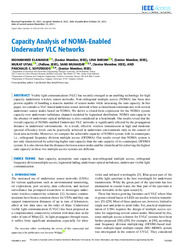Capacity analysis of NOMA-enabled underwater VLC networks
| dc.contributor.author | Elamassie, Mohammed | |
| dc.contributor.author | Bariah, L. | |
| dc.contributor.author | Uysal, Murat | |
| dc.contributor.author | Muhaidat, S. | |
| dc.contributor.author | Sofotasios, P. C. | |
| dc.date.accessioned | 2023-04-19T12:40:42Z | |
| dc.date.available | 2023-04-19T12:40:42Z | |
| dc.date.issued | 2021 | |
| dc.identifier.issn | 2169-3536 | en_US |
| dc.identifier.uri | http://hdl.handle.net/10679/8132 | |
| dc.identifier.uri | https://ieeexplore.ieee.org/document/9585115 | |
| dc.description.abstract | Visible light communication (VLC) has recently emerged as an enabling technology for high capacity underwater wireless sensor networks. Non-orthogonal multiple access (NOMA) has been also proven capable of handling a massive number of sensor nodes while increasing the sum capacity. In this paper, we consider a VLC-based underwater sensor network where a clusterhead communicates with several underwater sensor nodes based on NOMA. We derive a closed-form expression for the NOMA system capacity over underwater turbulence channels modeled by lognormal distribution. NOMA sum capacity in the absence of underwater optical turbulence is also considered as a benchmark. Our results reveal that the overall capacity of NOMA-enabled Underwater VLC networks is significantly affected by the propagation distance in underwater environments. As a result, effective wireless transmission at high and moderate spectral efficiency levels can be practically achieved in underwater environments only in the context of local area networks. Moreover, we compare the achievable capacity of NOMA system with its counterpart, i.e., orthogonal frequency division multiple access (OFDMA). Our results reveal that NOMA system is not only characterized by achieving higher sum capacity than the sum capacity of its counterpart, OFDMA system. It is also shown that the distances between sensor nodes and the clusterhead for achieving the highest sum capacity in these two multiple access systems are different. | en_US |
| dc.language.iso | eng | en_US |
| dc.publisher | IEEE | en_US |
| dc.relation.ispartof | IEEE Access | |
| dc.rights | openAccess | |
| dc.rights.uri | https://creativecommons.org/licenses/by/4.0/ | |
| dc.title | Capacity analysis of NOMA-enabled underwater VLC networks | en_US |
| dc.type | Article | en_US |
| dc.description.version | Publisher version | |
| dc.peerreviewed | yes | en_US |
| dc.publicationstatus | Published | en_US |
| dc.contributor.department | Özyeğin University | |
| dc.contributor.authorID | (ORCID 0000-0001-9416-3860 & YÖK ID 325395) Elamassie, Mohammed | |
| dc.contributor.authorID | (ORCID 0000-0001-5945-0813 & YÖK ID 124615) Uysal, Murat | |
| dc.contributor.ozuauthor | Elamassie, Mohammed | |
| dc.contributor.ozuauthor | Uysal, Murat | |
| dc.identifier.volume | 9 | en_US |
| dc.identifier.startpage | 153305 | en_US |
| dc.identifier.endpage | 153315 | en_US |
| dc.identifier.wos | WOS:000721992100001 | |
| dc.identifier.doi | 10.1109/ACCESS.2021.3122399 | en_US |
| dc.subject.keywords | Asymptotic sum capacity | en_US |
| dc.subject.keywords | Lognormal fading | en_US |
| dc.subject.keywords | Non-orthogonal multiple access | en_US |
| dc.subject.keywords | Orthogonal frequency division multiple access | en_US |
| dc.subject.keywords | Sum capacity | en_US |
| dc.subject.keywords | Underwater optical turbulence | en_US |
| dc.subject.keywords | Underwater visible light communication | en_US |
| dc.identifier.scopus | SCOPUS:2-s2.0-85118527954 | |
| dc.relation.publicationcategory | Article - International Refereed Journal - Institutional Academic Staff |
Files in this item
This item appears in the following Collection(s)
Share this page




